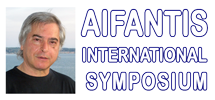List of Accepted Abstracts As of 15 March 2015: (Alphabetical Order)
Aifantis International Symposium
(2nd Intl. symp. on Multiscale Material Mechanics in the 21st Century)
Gudenau International Symposium
(3rd Intl. Symp. on Advanced Sustainable Iron and Steel Making)
Takano International Symposium
(1st Intl. Symp. on Sustainable Metals & Alloys Processing)
Meech International Symposium
(2nd Intl. Symp. on Sustainable Mining Operations)
2nd Intl. Symp. on Sustainable Mineral Processing: Principles, Technologies and Industrial Practice
Vanyukov International Symposium
(3rd Intl. Symp. on Sustainable Non-ferrous Smelting and Processing)
3rd Intl. Symp. on Sustainable Materials Recycling Processes and Products
3rd Intl. Symp. on Quasi-crystals, Metallic Alloys, Composites, Ceramics and Nano Materials
2nd Intl. Symp. on Sustainable Cement Production
4th Intl. Symp. on Environmental, Health, Policy, Legal, Management and Social Issues Related to Metals, Materials and Mineral Processing
2nd Intl. Symp. on Rare Earth and Platinum Group Metals: Managing and Processing
2nd Intl. Symp. on Sustainable Production of Ferro-alloys
3rd Intl. Symp. on Sustainable Molten Salt and Ionic Liquid Processing
2nd Intl. Symp. on Sustainable Secondary Battery Manufacturing and Recycling
2nd Intl. Symp. on Sustainable Base-metal Bio-extraction
2nd Intl. Symp. on Synthesis and Properties of Nanomaterials for Future Energy Demands
2nd Intl. Symp. on Sustainable Energy Production: Gas/Oil/Shale; Coal; Nuclear; Waste/Bioprocessing and renewables: wind/waves
3rd Intl. Symp. on Composite, Ceramic and Nano Materials Processing, Characterization and Applications
2nd Intl. Symp. on Sustainable Surface and Interface Engineering: Coatings for Extreme Environments
1st Intl. Symp. on Physics of Surfaces and Interfaces, from Fundamentals to
Sustainable Applications
1st Intl. Symp. on Advanced Materials and Technologies for
Sustainable Energy and the Environment(AMTSEE)
1st Intl. Symp. on Multifunctional and Smart Materials, Systems and Structures for Sustainability (MSMSSS)
2ND INTL. SYMP. ON RARE EARTH AND PLATINUM GROUP METALS: MANAGING AND PROCESSING
Compositional Characterization of Secondary Copper Anodes Obtained from Aqueous Residues of PM and PGM Refining Processes
N.
Deva1 ;M.
Rizaj2 ;I.
Duman3 ;F.
Kongoli4 ;
1PUBLIC UNIVERSITY OF MITROVICE - ISA BOLETINI - , FACULTY OF GEOSCIENCES, REPUBLIC OF KOSOVA, Mitrovice, Kosovo; 2UNIVERSITY OF PRISHTINA, Prishtina, Kosovo; 3ISTANBUL TECHNICAL UNIVERSITY, Istanbul, Turkey; 4FLOGEN TECHNOLOGIES INC., Mont-Royal, Canada;
Type of Paper: PlenaryThe refining processes of precious and platinum group metals generate large volumes of aqueous residues that contain considerable concentration levels of copper (Cu), gold (Au), silver (Ag), platinum (Pt), Palladium (Pd), Iridium ( Ir ) and other platinum group metals. One possible treatment of these residues is their use in the production of secondary copper anodes (SCA) which in turn can be used in electrolytic refining processes to separate PM, PGM and other elements that these SCA contains.
This work, which is part of a bigger study on separation of Au, Ag, Pt, Pd and Ir from anode slime gained from secondary copper, describes a compositional characterization of secondary copper anodes obtained from various aqueous residues. It was found that SCA contains Cu, PMs, PGM and some other recoverable metals such as nickel, selenium and tellurium. The composition of the secondary copper anodes differs from the composition of the primary Cu anode. Although SCA contains less precious metals and PGM compared to primary Cu anodes, they still have enough market economic value that justifies refining of these anodes and finding effective methods for extraction of these valuable metals from them. One of this method is electrolytic refining process that is based on differentiated behavior during electrolysis of each impurity found in this study. Keywords: secondary copper anodes; residues; waste waters; composition; precious metals; platinum group of metals
Electrodeposition of Rare Earth Metals from BMPTFSI Ionic Liquid
D.
Panias1 ;E.
Bourbos2 ;I.
Giannopoulou2 ;
1, Athens, Greece; 2NATIONAL TECHNICAL UNIVERSITY OF ATHENS, Athens, Greece;
Type of Paper: RegularProduction of rare earth metals and alloys is conventionally performed by high temperature molten salts electrolysis, which creates highly corrosive environment and demands high energy consumption. Recently, the use of organic solvents has been implemented; however, they were considered inadequate, due to their high volatility and flammability. Ionic liquids (IL) gain increasing attention in the recent years as electrolytes for the recovery of drastic metals. The type of cations and anions adjust the properties for ILs, such as low melting points, chemical and thermal stability, negligible vapour pressure, ability to dissolve a wide range of compounds, ionic conductivity and broad electrochemical window.
The reduction of rare earth cations (e.g. La, Sm, Nd, Dy) to the metallic state and their subsequent electrodeposition in BMPTFSI is studied. This hydrophobic ionic liquid presents a wide electrochemical window and a satisfying ionic conductivity rendering it a promising electrolyte for the rare earths reduction. A study of different systems in order to address the dissolution problem of rare earths in ionic liquids and the problem of the anodic reaction during cathodic polarization has also been realized. Cyclic voltammetry (CV) performed on a Pt electrode in a three electrode cell revealed that rare earth cations can be reduced to the metallic state in the above mentioned ionic liquid. Furthermore, the electrodeposition of rare earths was realised on a copper substrate, under potentiostatic conditions for 5h at -3.1 V at 25°C and the electrodeposits were examined in SEM and EDS analysis, revealing rare earths electrodeposition.
It is concluded that BMPTFSI is an appropriate ionic liquid for rare earths electrodeposition and the optimum conditions for achieving concentrated solutions and hindering decomposition of the ionic liquid in the anode are presented. Keywords: Hydrometallurgy; Materials; RareEarth;
Exploring the Magnetic Properties of Ferrite Nanoparticles for the Development of Rare-Earth-Free Permanent Magnet
C.
Sangregorio1 ;
1ICCOM-CNR, Sesto Fiorentino, Italy;
Type of Paper: KeynoteCurrently, there is a rising demand for rare-earth (RE) elements for a broad range of industrial applications. However, the risk of supply of these strategic materials due to political restrictions, the high environmental impact of their extraction as well as price oscillations have motivated many researchers in finding viable alternatives. Specifically, in the case of permanent magnet applications, the research is focusing on finding novel materials that can replace currently used RE permanent magnet in a wide part of the spectrum of industrial necessities where the high performance of RE permanent magnets is not strictly required.
In this contribution, we discuss the potentiality of ferrite NPs to achieve this goal. In particular, we will focus on cobalt ferrite nanoparticles (NPs) with average size covering a broad range (from 4 to 60 nm) synthesized by thermal decomposition of metal-organic precursors. We will show how the fine tuning of morphological, structural and chemical features may strongly increase their (BH)max product, which is the figure of merit of permanent magnets. The possibility of further improvement of the nanomaterial performance by orienting the nanocrystals or coating the hard core with a soft ferrite (exchange coupled core/shell nanoparticles) will be also discussed.
Research supported by EU-FP7 NANOPYME Project (No. 310516) [www.nanopyme-project.eu]
« Back To Technical Program
|



